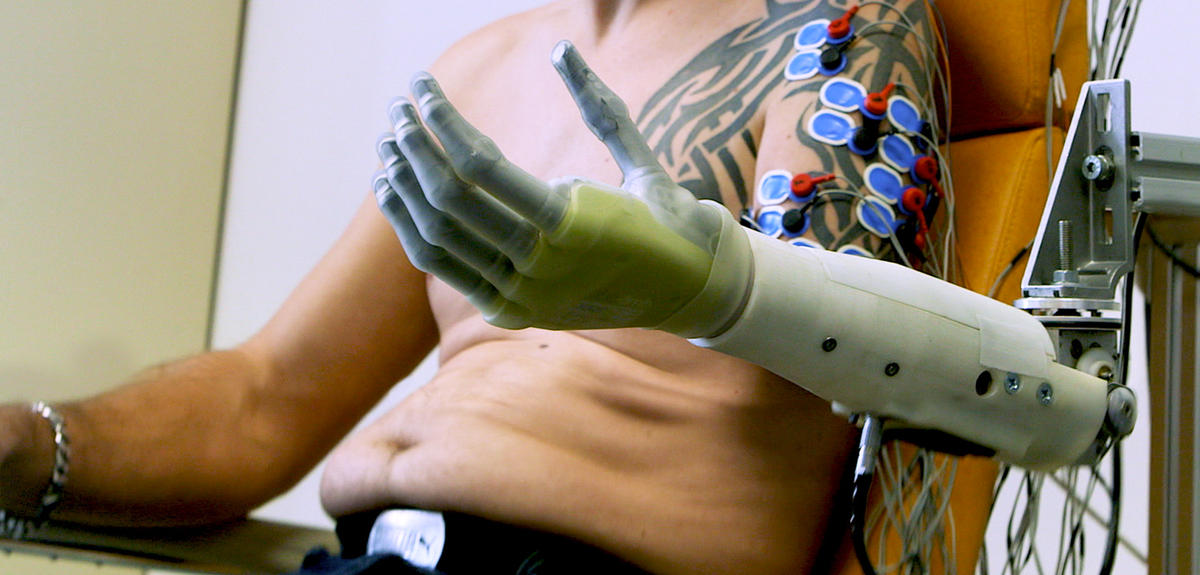You are here
Phantom Limb
The robotic prosthetic limb (the prosthetic limb, roboticized). A seemingly ideal solution for those who have lost an arm to amputation.
Even though technological progress has led to high-performance prosthetics, it isn’t enough.
The controls need to be more natural. And the actual manner in which they’re controlled requires too much effort for many of their users.
ITV - M
We measure electromyography, or muscular electrical activity. By concentrating, the patient can control their robotic elbow. Then, once the elbow is properly positioned, they can send a signal to the prosthesis to say “I want to change what I’m controlling,” and for example move their concentration to the wrist.
Much like a musical instrument, using a prosthesis like this requires a lot of practice, especially for people with amputations above the elbow.
ITV - Josina de Graaf
It’s already difficult for patients to learn how to flex their bicep or tricep alone, something that seems impossible because they usually contract at the same time, in order to control multiple parts of their prosthesis. It’s really difficult and can be frustrating in the moment.
So, how does one control it in a more intuitive way? A research team has found a particularly promising track. These robotics experts, doctors, and neuroscientists are studying an innovative, ambitious approach they’re calling “Movable Phantom Limb.”
ITV - Josina de Graaf
Ultimately, what is a phantom limb? It’s the lingering sensation of a limb’s presence after it’s been removed.
ITV
We’ve recently demonstrated that over 75% of arm amputees feel their phantom limbs, sensations they can interact with, which means phantom limbs they can move.
Josina de Graaf
When you put your hand on their arm – we’re talking about what remains above the elbow obviously – when they move their phantom limb, you can feel muscular contractions under your hand. Thus the mobility of a phantom limb is demonstrated through these contractions.
If the missing limb is effectively a “phantom,” its movement still produces real muscular signals. Even if the movements being carried out are complex.
Josina de Graaf
It’s amazing to see that when an amputee moves their phantom fingers, there are muscular contractions in the residual tissue. This doesn’t happen in an intact limb. There’s a hypothesis that suggests that after nerves have been cut, they will reinnervate the remaining muscle fibers in the arm.
These subtle signals from the phantom limb, projected within the remaining tissue, are what the researchers want to exploit. And rather than demand that the patient learns to use their prosthesis, they want to make one that would adapt to the patient’s intent.
ITV - M
The main objective of the project is to create algorithms capable of decoding what the phantom limb is doing in real time, and follow its movement, simply by reading the muscular contractions in the residual tissue.
What you can see on the screen are recordings of the data gathered from the participant. We placed electrodes along his residual limb and recorded them as they carried out a certain number of phantom movements. We’ll enter this data and into a self-teaching algorithm which will personalize itself to this individual, including learning what kinds of muscle contractions correspond to which phantom movements. It will be enough to adequately control the prosthesis.
As the technology is refined, comprehensive clinical attempts to control the prosthesis can be carried out.
The protocol for these experiments comes in two parts. The first, which wasn’t filmed, consists of creating and training the algorithm to fit the participant.
We filmed the parts of the tests where the participants were in control of the prosthesis, through moving their phantom limbs, in order to complete functional tasks in manipulating objects.
On top of enabling a more natural form of prosthetic control, these tests are creating a new, constructive outlook on the idea of the phantom limb, which until now was simply considered a psychological side effect…
ITV - F
This removes a taboo. Often the response a patient would receive when talking about their mobility was “you can’t move something that isn’t there.” And the patients would worry they were strange. This, I hope, will change with our study.
These promising early results have encouraged the team to continue their exploration of the phantom limb. Their study could one day enable amputees to control their prosthetics as naturally as their own arms.
From Phantom Limb to Prosthetic Arm
For amputees, controlling a robotic prosthesis is far from a perfect solution. It can take months of training before they can perform basic day-to-day operations. In France, a team of researchers, engineers and medical doctors are developing a more natural method for controlling such a prosthesis using a phenomenon known as phantom limb sensation.
Institut des Systèmes Intelligents et de Robotique (ISIR)
CNRS / Sorbonne Université / Inserm
Jozina de Graaf (CNRS)
Institut des sciences du mouvement - Etienne-Jules Marey (ISM)
Université Aix-Marseille / CNRS





